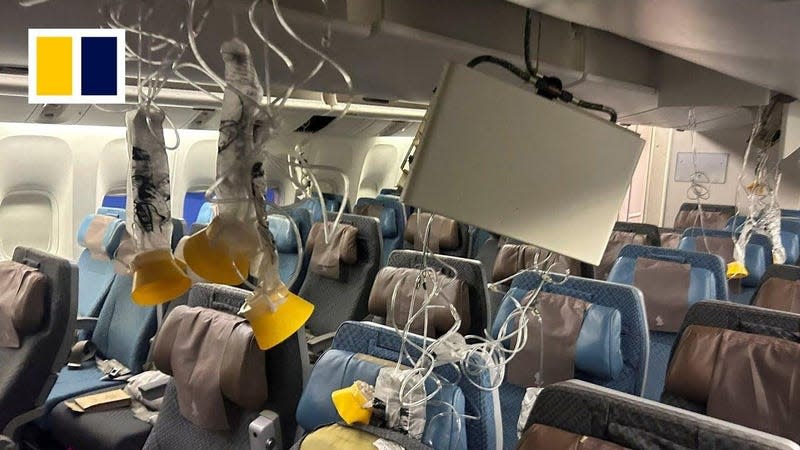Here's What Airplane Passengers Experienced During The Worst Turbulence-Related Accident In Decades

Earlier this week, a Singapore Airlines flight from London to Singapore was thrust into chaos and forced to make an emergency landing in Bangkok following severe turbulence that left a 73-year-old British man dead and injured over 104 other passengers. In just a couple of minutes, the Boeing 777-300ER dropped nearly 6,000 feet.
Oxygen masks dropped down, but so did some of the boxes that were actually holding them in place, according to the Wall Street Journal. People were thrown through the air across the aisle. That’s how much force we’re talking about here. Now we’re getting an inside look at what those scary few minutes on the plane were like from passengers who were there.
Ali Bukhari, a 27-year-old Australian engineer who was with his wife returning from their honeymoon spoke with the Wall Street Journal about what they saw and felt:
“My wife and I thought we were going to die,” Bukhari said. “We didn’t think we were going to make it.”
Bukhari and his wife were unharmed; they had their seat belts on. But many others were badly hurt. Blood streaked down faces. Someone was pumping the chest of a man whose body lay on the floor, Bukhari said.
Just then, he had a frightening thought: What if something was wrong with the plane? He considered looking through a window for signs of external damage but resisted for fear of what he might see. Surely, turbulence couldn’t cause that much harm, he thought.
The plane was caught in one of the worst turbulence-related accidents ever, and the 73-year-old man who died was the first fatality on a commercial flight involving turbulence in nearly three decades. 104 more passengers received medical treatment in Bangkok, and 20 of them are still in the ICU.
Here’s some more on the injuries suffered by passengers, from WSJ:
At one of the hospitals where many of the victims were taken, six were found to have skull and brain injuries, and 22 suffered injuries of the spine or spinal cord. Some patients have shown signs of paralysis, though it isn’t yet known if the damage is permanent, said Dr. Adinun Kittiratanapaibool, director of Samitivej Srinakarin Hospital, a private medical facility. At least 17 have undergone surgery.
The outlet also spoke with Keith Davis, a 59-year-old landscape architect from Australia who said the incident left him in shock. Davis was adjusting his seat when he noticed his wife’s water glass shaking. Before he could even do that, he and his wife were airborne.
His wife crashed into an overhead luggage bin and then landed in the aisle. His head went straight through a ceiling panel and he landed back in his chair.
[...]
He said the first thing he did was lean over his wife and ask if she was OK. “Then I realized I was dripping blood all over her,” he said.
His wife, Kerry Jordan, is in an ICU but is stable and conscious. Davis had mostly superficial injuries—a laceration along his hairline that caused a lot of bleeding, and a black eye—and localized pain in his right shoulder.
In the chaotic moments after the incident, his biggest concern was keeping his wife still. He braced his legs around her to pin her in place and keep anyone from moving her until they reached safety, he said. The couple, who had been on vacation in the U.K., now just wants to get back home—but that means getting on another plane.
WSJ also spoke with one passenger, 54-year-old Andrew Davies who wasn’t terribly injured. Because of that, he went around the cabin to help other folks who weren’t as lucky.
Davies said the seat-belt sign went on just before the plunge. “It was a very sudden, sudden drop,” he said. It seemed to end as abruptly as it began.
“There wasn’t really enough time for me to think, ‘Oh my days, is this going to stop?’” he said.
Moving around the aircraft to help the injured, Davies saw passengers scrambling in all directions, squeezing past one another. They had to weave through fallen objects, even people sprawled on the floor, he said.
A man in business class had a big cut on his head. Farther down, another holding his chest looked to be in extreme pain. A woman had hurt her back and was screaming in agony. A gash on the ear of another was bleeding onto her white shirt.
Davies and others moved an unconscious elderly man out of his seat, laying him down near an emergency door, where there was more space. A passenger with medical training called for a defibrillator, which a hobbling cabin-crew member brought over. They administered CPR for at least 20 minutes, and then someone said: “I think we need to stop,” Davies recalled.
“That’s my husband, that’s my husband,” his widow said repeatedly.
About 15 minutes after the incident, the pilot – who was “visibly shaken” limped into the cabin and told passengers what had happened and what he saw was pretty much a nightmare. Here’s what it looked like inside, from the Wall Street Journal:
The turbulence, lasting about a minute, left the cabin looking like the site of a hurricane. Food and drinks were splattered across the overhead luggage compartments. Some ceiling panels had fallen, causing the plane’s innards—jumbles of pipes and tubes—to tumble out.
In corridors and in galleys where flight attendants prepare meals, food trays had slid out of racks. Strewn across the floor were packets of chips, bottles of water, broken wine glasses, cups of coffee, kettles, apples, sliced kiwi.

 Yahoo Autos
Yahoo Autos 